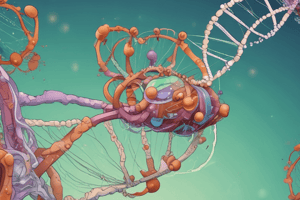Podcast
Questions and Answers
If a particular mRNA codon is UAG, the corresponding tRNA anticodon would be ATC.
If a particular mRNA codon is UAG, the corresponding tRNA anticodon would be ATC.
False (B)
Transcription is the process where tRNA molecules transport amino acids to the ribosomes, using the mRNA sequence as a guide.
Transcription is the process where tRNA molecules transport amino acids to the ribosomes, using the mRNA sequence as a guide.
False (B)
Noncoding DNA sequences play no role in cellular processes and are essentially 'junk' DNA with no function.
Noncoding DNA sequences play no role in cellular processes and are essentially 'junk' DNA with no function.
False (B)
The start codon, typically AUG, signals the beginning of translation and codes for the amino acid methionine.
The start codon, typically AUG, signals the beginning of translation and codes for the amino acid methionine.
Peptide bonds are formed between mRNA codons during the translation process to create a polypeptide chain.
Peptide bonds are formed between mRNA codons during the translation process to create a polypeptide chain.
Flashcards
Protein Synthesis
Protein Synthesis
The process of creating proteins from DNA.
Transcription
Transcription
The first step of protein synthesis where mRNA is created from DNA.
Ribosomes
Ribosomes
Cellular structures that synthesize proteins from mRNA.
Codons
Codons
Signup and view all the flashcards
Start Codon
Start Codon
Signup and view all the flashcards
Study Notes
Protein Synthesis: From DNA to Protein
- DNA codes for traits: Eye color is determined by pigments, produced by proteins. Genes, DNA segments, code for these proteins.
- Protein Synthesis: Creating proteins from DNA.
- Importance of Proteins: Essential for life, performing various functions: transport, structure, enzyme activity, protection.
- Cellular Location of DNA: Found in the nucleus of most cells.
- Noncoding DNA: Some DNA does not code for proteins.
- Transcription: First step, in the nucleus. RNA polymerase uses DNA as a template to make a complementary mRNA molecule.
- Messenger RNA (mRNA): Carries genetic code from DNA nucleus to cytoplasm.
- mRNA Editing: Modified before leaving nucleus.
- Ribosomes: Located in cytoplasm, responsible for protein synthesis.
- Ribosomal RNA (rRNA): Component of ribosomes.
- Translation: Second step, occurring at ribosomes.
- Transfer RNA (tRNA): Transports amino acids to ribosomes.
- Amino Acids: Building blocks of proteins.
- Codons: mRNA read in three-base sequences.
- Anticodons: tRNA complementary sequences matching mRNA codons.
- Codon Chart: Determines amino acid for each mRNA codon.
- Start Codon (AUG): Codes for methionine, protein synthesis start.
- Stop Codons: Signal protein synthesis end, do not code for amino acids.
- Peptide Bonds: Link amino acids to form polypeptide chains.
- Protein Folding and Modification: Proteins often fold and modify after translation to achieve final form.
Studying That Suits You
Use AI to generate personalized quizzes and flashcards to suit your learning preferences.




